Abu Saleh, a 73-year-old farmer, speaks with a raspy but strong voice as he points to his crops. “Everything you see around you is food grown from my own land. These carrots, this zucchini, these olives…they are all part of my survival.” He lifts his head, his voice starting to shake with anger. “Now they want to tear down my home and remove me from my livelihood. They want to rip my heart from my land – just to put the heart of someone else.”
Abu Saleh is a resident of Ramiya, an Arab community of 50 families nestled within the Jewish city of Karmiel in northern Israel. The vast majority of visitors to Karmiel will never know that Ramiya exists at all: it is hidden behind a wall of clustered bushes, making it easily mistakable for forestation that was waiting to be cleared. From the main road, the only sign of the village’s existence is a wooden shack with a banner reading “Remaining in Ramiya” in Arabic and Hebrew next to an image of the Palestinian cartoon Handala stopping a bulldozer in its tracks.
Ramiya, which has been continuously populated since the Ottoman Empire, once encompassed nearly 600 dunams, or 150 acres, of agricultural land. But in 1976, the Israeli government seized most of the village’s property along with those of many other Arab villages across the Galilee. On March 30th of that year, thousands of Palestinian citizens of Israel protested the sweeping confiscations in what became the first “Land Day,” a day of protest and commemoration marked every year since. The 1976 demonstrations, some of which were held not far from Ramiya, were brutally suppressed by Israeli police, who killed six Palestinian protesters and wounded scores more.
The confiscated land was used to build hundreds of new Jewish towns and cities in line with a national development plan called “the Judaization” of northern Israel. Karmiel, the city that surrounds Ramiya today, was established on land belonging to several Palestinian villages, including Ramiya. Today luxury apartments belonging to wealthy Jewish Israelis cover the area, with construction sites nearby breaking ground in preparation to build even more. “Israelis forget that we were not dropped onto Karmiel,” says Abu Saleh. “Karmiel was dropped onto us.”
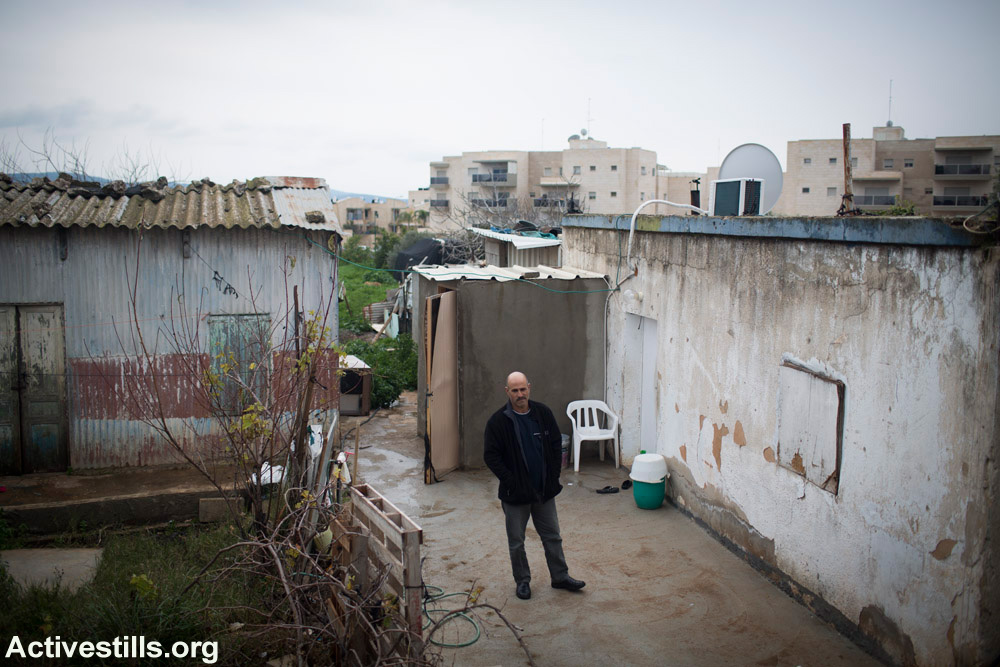
For years the Karmiel Municipality has pressured its Palestinian residents to yield the remainder of their property and to relocate to another area on the city’s outskirts – a proposal which the residents view as insensitive to their historical and personal attachment to their homes. Abu Saleh recalls: “Officials from the Land Authority entered the village and looked around at our homes and our gardens, and offered us money to give it all up. I told them, ‘Why do I need your money? I have everything I need right here – just leave me my land, for the love of God!’”
The Karmiel Municipality has insisted that the families accept a relocation plan presented to them in 1995; but the proposal is hardly amenable. The land being offered to them is a mere fraction of what the families own; the plan gives no space or consideration for Ramiya’s natural growth or agricultural way of life; and the villagers are skeptical that the city will connect them to the water supply, electricity grid, and other basic services that the residents have been forced to acquire privately or illegally for decades. “The municipality knows what it is doing,” adds Abu Saleh. “They know that to restrict our livelihood is to take away our strength.”
The villagers went to the Israeli Supreme Court demanding that they be allowed to stay on their land, but the court ruled in November 2015 that the families must accept the old offer or be forcibly evicted. Ramiya has since stepped up its campaign to rally public support, bringing Arab journalists, activists, and leaders to the village, including elected representatives from the Joint List. “Right now in my view, a pilgrimage to Ramiya is more important than a pilgrimage to Mecca,” says Saleh, the son of the elder famer. “Our lives here are in immediate danger,” adding wistfully, “Saudi Arabia, meanwhile, is a source of danger to others.”
The men of the village express hope that they can change their fate before the relocation plan is forcibly imposed on them. But not everyone feels the same. As we walk by several homes, a woman asks Abu Saleh who the visitors are. Young people to help the struggle, the old man answers. “‘Al fathi, Abu Saleh,” the woman replies – it’s all for nothing. “Don’t say that ya hajji,” replies Abu Saleh. But the woman is unmoved. “Twenty years we’ve been trying, Abu Saleh. How can I not lose hope?”
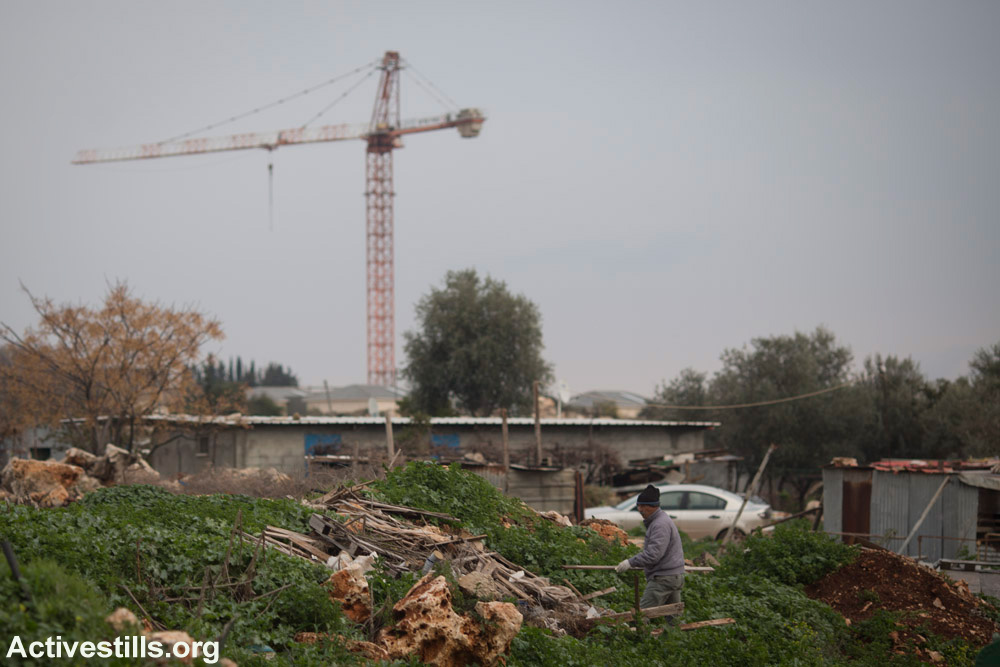
***
Anyone who has visited Palestinian communities in Israel or in the occupied West Bank has heard Ramiya’s story in one form or another. You can hear it from families of the Jahalin Bedouin tribe in East Jerusalem, who are being evicted in order to link Israel’s settlements in the “E1” area. You hear it in the Arab Triangle inside Israel, whose towns are overcrowding due to highways and strategic Jewish towns blocking their expansion. You hear it in the South Hebron Hills, where Palestinian villagers are being displaced to make way for IDF firing zones. And you hear it in the Naqab (Negev), where Bedouin citizens are being forced into townships to make room for new Jewish communities and forests being built on their villages’ ruins.
Palestinians have commemorated the Land Day protests every year since 1976. But four decades later, it is clear that their activism has not left a mark on Israeli policy. Many of the mechanisms that forcibly transferred Palestinian land to Jewish ownership remain active to this day: a national land authority owns 93 percent of the country’s territory; a quasi-state actor, the Jewish National Fund, forbids the sale of property to non-Jews; admissions committees enforce housing segregation; obstinate planning authorities refuse to increase Arab towns’ jurisdictions. The list goes on.
In recent years, Israel has designed even more methods to enhance its discriminatory land governance, allowing it deepen the racial divide within its 1948 borders and effectively annex large swaths of the 1967 occupied West Bank. Far from repairing unjust land policies, Israel has given Palestinians new reasons to recognize March 30th as a day to protest their existing conditions, not only to remember the past.
Ramiya is just one out of dozens of unrecognized Arab villages in Israel that illustrate the “ongoing Nakba” faced by tens of thousands of Palestinian citizens. Dahmash, a community just a short drive from Tel Aviv, is also facing the threat of demolition. Like Ramiya, Dahmash existed before Israel’s establishment but does not exist on any official maps. Its residents do not receive even the most basic services from the authorities. “Dahmash is a thorn in Israel’s throat because we are the only Arab village remaining in the center of the country,” said Kais Nasser, the attorney representing the village.
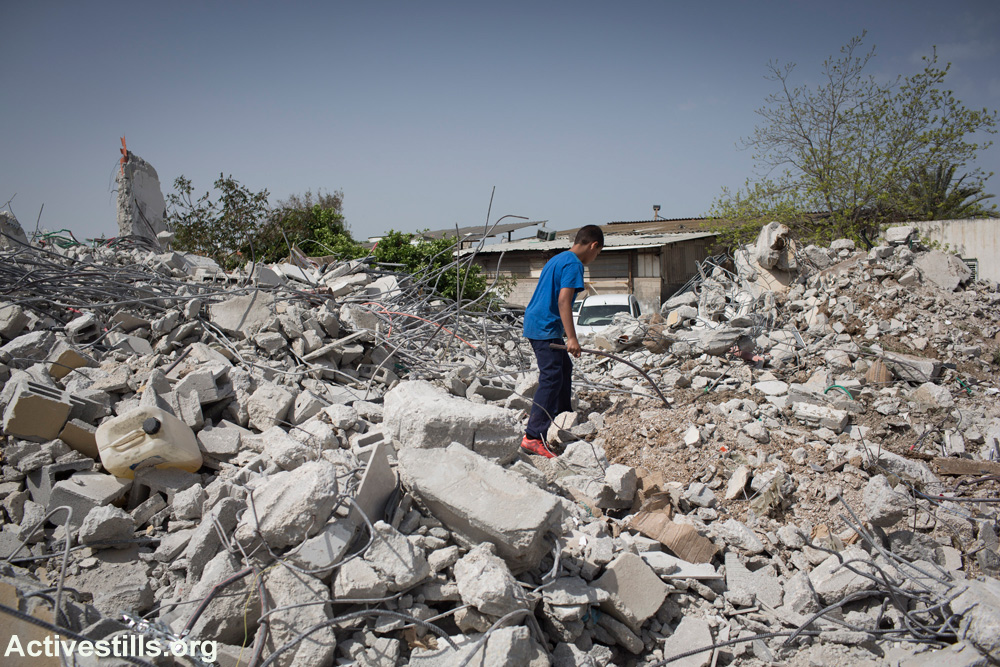
In a small but rare victory in March 2015, Dahmash convinced the Israeli Supreme Court to recommend to the government that it recognize the village and allow its residents to remain on their land. But that has not stopped the state from moving forward with its plans. The following month, armored police units surrounded the village in the early hours of the morning and demolished three homes on the outer edges of the village. The incursion seemed intended to send a deliberate message to the village’s residents: your presence here is still illegal, and we still want you out.
“There was no notice before the police arrived,” says Mayyada, a resident of Dahmash. “They woke us up and the children were terrified…It wasn’t easy to watch,” she adds. “Our biggest worry is always the effect on the children. You can’t go to sleep at night without wondering if you’ll wake up to find your home is about to be destroyed. It is no way to live.” Mayyada’s young daughter wrote a poem in school a few days later describing how the police stormed into their home with dogs and guns.
Another woman, Shirin, contrasts the treatment of Dahmash’s Arabs with Jews living in the occupied Palestinian territories. “The state gives settlers beautiful homes and provides them with everything on land that is not their own. We are on our own land and in our own homes, living happily and asking for little. The government can’t stand this. What is happening to us now is the same as what is happening in the West Bank. A concrete wall divides us, but the policy is the same here as it is there. We Arabs are all the same to them.”
In the ensuing months, the Israeli authorities continued to insist on their intention to carry out the demolition orders against many of the village’s homes. Nasser has had to file repeated appeals to the district courts seeking injunctions to freeze the demolitions until a final agreement is reached. “We have been using Israeli law for years, but we are constantly worried that the law will fail us,” Nasser explains. “The state only sees us Arabs as infiltrators, thieves, people who don’t belong here. It never sees us as human beings, as having rights to the land. If you want proof that Israel does not believe in democracy or equality, Dahmash is your proof.”
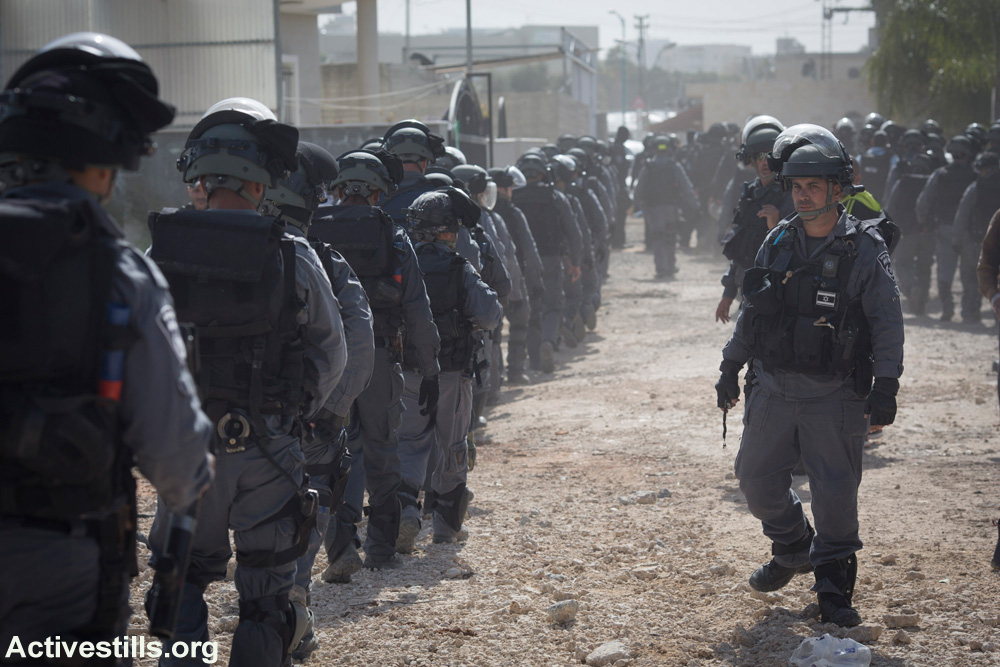
***
Palestinian citizens have always been skeptical about using Israeli institutions to defend their rights as citizens. Despite that skepticism, there was a cautious hope since the 1990s that some progress could be made. Legal centers and human rights organizations started petitioning the Supreme Court en masse over cases they believed could set precedents for the Palestinian minority at large. Political parties were established or revitalized to advocate for the Arab community’s needs and aspirations in the Knesset and public sphere. Arab youth became more active and assertive of their Palestinian identity, using social media as a tool for community education and mobilization. This cautious hope still exists for some people, including Nasser who believes that, “if Dahmash succeeds in overturning the demolition plans, it can change the picture for other Arab communities across the country.”
Today, however, most Palestinian citizens are returning to the unsettling realization that Israel’s political, legal, and judicial institutions remain as aggressively geared against their land rights as they were decades ago. New laws and policies enacted by the government are entrenching practices of segregation, resource inequality, and annexation – and these policies are being rubber-stamped by Israel’s judiciary. The bench of the Supreme Court, the purported “liberal vanguard” of Israeli democracy, is being filled with justices who are at best reluctant to intervene in the state’s affairs, and at worst are openly supportive of the state’s discriminatory goals.
No case exemplifies this better than the twin Bedouin villages of Atir and Umm al-Hiran in the Naqab. Although Israel’s military government moved the families to their current lands in 1956 after displacing them from their homes in 1948, the state has decided to displace the now 1,000 Bedouin residents yet again. In place of Atir, Israeli authorities want to expand a JNF-funded forest called “Yatir,” and in place of Umm al-Hiran, they plan to build a new Jewish town called “Hiran.” Construction for the new town is currently under way just a few meters away from the Bedouin homes while the incoming Jewish residents wait in a temporary encampment in the Yatir forest.
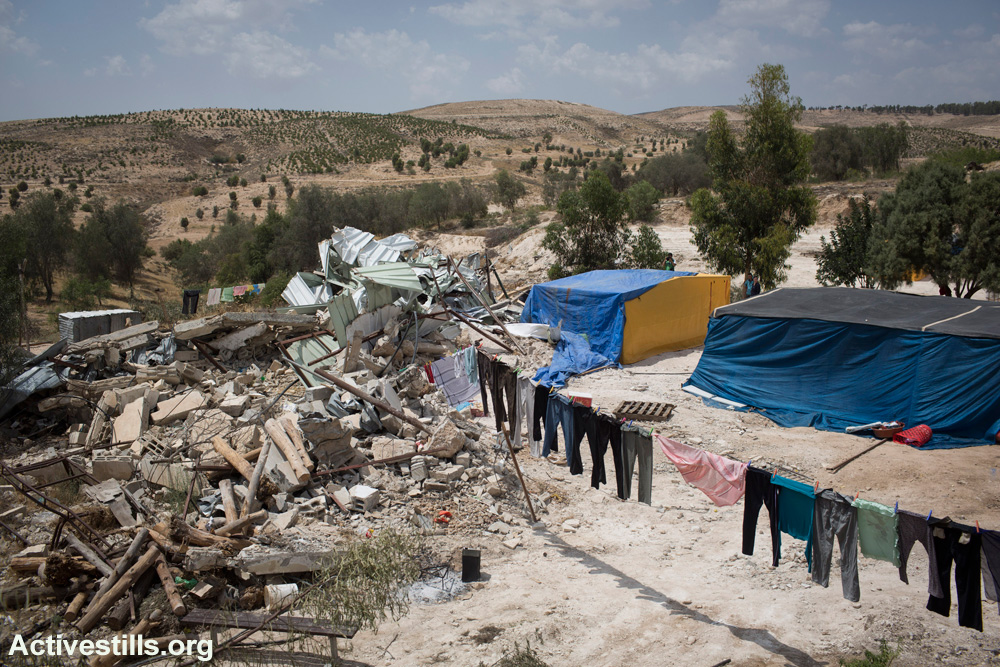
Atir and Umm al-Hiran waged an arduous 13-year legal struggle against the plans to displace them. But in May 2015, the Supreme Court dismissed their final petition and refused to reconsider its decision. The main argument it made was that although the Bedouin families were not trespassers as the state claimed, the land on which they live is still technically state land; thus, the state could rescind permission to live there as it wished. The court further argued that the Bedouin villagers were being amply compensated by being relocated to Hura – an urban township in the middle of the desert mired in poverty, crime, and its own housing crisis.
“The state likes to claim that it is modernizing the Bedouin by moving them to cities – yet at the same time, it is supporting Jewish citizens to build their own rural individual farms across the Naqab, including on the ruins of Bedouin villages,” says Suhad Bishara, the attorney and acting director of Adalah (the NGO where I work) who represented Atir and Umm al-Hiran. Bishara argues that the court’s ruling gives Israel a legal stamp of approval to carry out the rest of the Prawer Plan, which would see 35 villages in the Naqab destroyed and up to 70,000 Bedouins forcibly displaced.
“There is no difference in the eyes of Israel’s land regime between a Palestinian with Israeli citizenship and a Palestinian under occupation,” Bishara adds. “Umm al-Hiran in the Naqab is exactly the same as Susiya in the West Bank. It is the same colonial policy driven by the same racist ideology.”
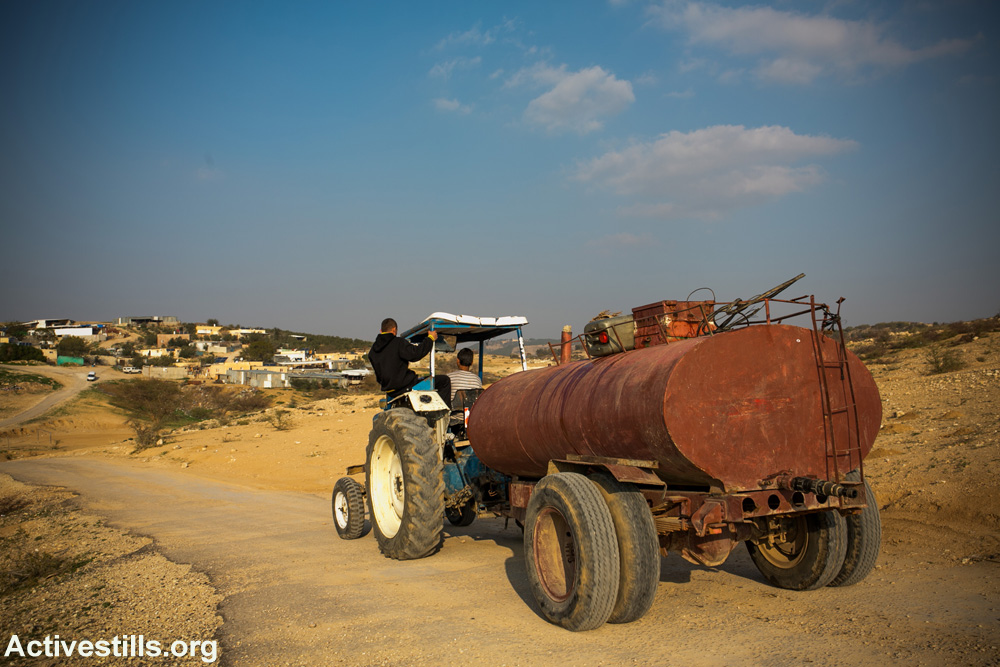
***
It is difficult to find optimism these days for the future of the unrecognized Arab villages. They have used every means at their disposal to challenge and change Israel’s discriminatory policies – only to find that the state viciously fought back at every turn. Yet the villagers continue to find rays of hope in the face of tragic circumstances – a trait that many Palestinians proudly refer to as sumud: steadfastness, or resilience.
Contrary to what many Jewish Israelis might assume, the Palestinian community in Israel has never been passive in the face of threats to their rights. Together with Jewish partners, Palestinian civil society in Israel has put forward political declarations like the Future Vision Documents and land proposals such as the Alternative Master Plan for the Negev. Palestinian citizens’ day-to-day interaction with Jewish Israelis further signal the desire to build a shared society based on mutual respect and dignity.
“Why do we have to be Jewish and Arab?” asks Abu Saleh in Ramiya. “We share our food with everyone, and our children go to school in Karmiel. I don’t care about politics. I just want to remain on my land, and to be able to die in my own home. But they want to enclose me with concrete walls, and to separate me from my land. I cannot live like that. Al-arth il haya” – land is life.
Abu Saleh’s message is echoed by Ra’ed Abu Al-Qi’an in Umm al-Hiran, where one of several Land Day protests were being held this year. “We have always said we would have no problem expanding our village to include both Arabs and Jews. What we do not accept is a plan that puts Jewish rights above our own, and at the direct expense of our homes. There is plenty of land in the Naqab, even around Umm al-Hiran. There is no reason why we can’t live as equals.”
Special thanks to Hamleh for the tours, and to the people of Ramiya, Dahmash and Atir/Umm al-Hiran.


